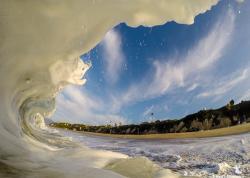5 Reasons To Go Mirrorless

As an underwater mirrorless shooter and u/w photography instructor I am frequently quizzed about why I shoot micro-four-thirds and not dSLR. Compact camera shooters often ask for advice on whether they should take the next step into the interchangeable lens systems.
The truth is that in my experience (from point-and-shoot to full frame dSLRs) the current generation mirrorless systems has struck the perfect balance between high-end image quality and physical practicality. Even in my commercial photography, our business is transitioning from our full frame kit to the more affordable and far more flexible Olympus OMD EM-1 mirrorless camera. Time and time again I have left gear at home because it was too cumbersome to lug around. They say, “the best camera is the one you always take with you”, but what if it could actually deliver top image quality as well? Cue the mirrorless cameras, where convenience meets quality.

1. Bigger Doesn’t Always Mean Better
Saving your back and your excess luggage bill
With divers carrying around tens of kilos/pounds of dive equipment, the weight and size benefits of mirrorless camera systems has already swayed many photographic pros and enthusiasts.
Think back to the first television in your household. Do you ever yearn for ‘the good old days’ of the tube TV? Or, like me, do you kick back in front of your flat screen and admire how amazing the HD picture quality is and how convenient it is that this technology can sit so elegantly, mounted flush against your wall? This is exactly how I see the digital camera space. While no one is questioning the capability of dSLRs, they are still modeled around a bulky mechanical mirror system that was patented in 1861 (slightly older than the modern typewriter, patented in 1867). But like the flat screen TV, the mirrorless systems have replaced archaic components with miniaturized digital technology to achieve a smaller yet equally capable camera.
My entire Olympus OMD EM-5 rig, including camera, lenses (for both underwater and land), strobes, housing, glass dome port, tray & arms, all fits in my hand luggage when traveling…. just.

2. Bang For Your Buck
A bigger oven does not a good chef make
I recently read a story where somebody was hosting dinner and was complimenting an attending photographer on his images by saying something along the lines of, “I love your photographs; you must have a big professional camera,” to which he responded, “why thank you. And this is an amazing dinner; you must have an amazingly large oven.” When all is said and done, your photographs are the product of your hard work and your gear is simply a set of tools to help you best achieve it. Your images should be what make you a good photographer, not your ability to remortgage your house to afford a camera rig.
With imaging technology advancing so quickly, we are seeing that the gap between image quality on even the top dSLR and mirrorless systems reduced to the perception of ‘pixel-peepers’ and lab tests. The reality is that in your everyday shooting, pixel by pixel examination is irrelevant. A jaw-dropping photograph is art not science.
To that end, lets debunk the most common misconceptions about mirrorless image quality. This is based on my firsthand experience:
Rumor: The noise levels on mirrorless cameras can’t stand up to high-end dSLRs.
Fact: This is the most common criticism when comparing systems, but the reality is that the noise differences are only obvious in very extreme circumstances at rarely used high ISO ranges.
Rumor: The high-end mirrorless cameras are only 16MP.
Fact: While true, this is actually more than enough pixels for even large prints (look at the $6500 flagship 16MP Nikon D4S).
Rumor: Lens sharpness on mirrorless systems can’t compete and the lenses aren't fast enough for the low depth of field I need.
Fact: This comment predates the latest generation of fast primes and super-pro constant aperture lenses available. We’ve included some images in the article as rock-solid evidence.
Finally, it is important to note that these general comparisons are against the high end dSLRs on the market. The latest high-end mirrorless systems are capable of blitzing the low-mid end dSLR models.
To put this into context as divers, it is important to understand that while we shoot in extreme conditions physically, we generally bring light with us (strobes or otherwise), meaning that the high ISO advantage of top-end dSLRs is actually irrelevant to most of our shooting (90% of my own work is shot below ISO400). Over the past two years, my Olympus mirrorless prints have never been questioned when it comes to image quality, even when printed in large formats.

3. Keeping it Simple
Built-in tools to get results
When I go diving I am in my own tranquil bubble of heaven; my cares and concerns in the terrestrial world melt away and for that hour of scuba-silence my life feels complete. I am completely enthralled in viewing the underwater world with an artistic eye and capturing the things that I see as simply and as creatively as possible. This is where mirrorless cameras really shine.
Having an electronic viewfinder (EVF) and Live View LCD screen means mirrorless shooters can take advantage of a lag-free ‘live view’ experience traditionally found on point-and-shoot cameras. I change a setting and my live preview is immediately updated. This takes some of the guesswork out of your shooting and eliminates much of the trial and error associated with light metering with an optical viewfinder. This leaves you free to focus handy focusing tools like focus peaking and spot magnification, giving underwater shooters precise focus control in macro situations. It is also worth noting that being a completely digital experience, you are also able to switch these features on and off if you prefer the more traditional approaches.
When you look at a stunning image, do you scrutinize over how the photographer calculated the camera settings or simply admire the creative result? Personally, if I can capture an image with half the effort I am one happy person.

4. Everybody’s Doing It
A fully supported camera system
Unfortunately for those seeking fame as a mirrorless pioneer, you are too late. These days almost every manufacturer is producing underwater housings, ports and accessories for the mirrorless systems and there is overwhelming evidence that these systems are not only here to stay, but the future. Any accessory you can get for your dSLR, you can almost certainly get for your mirrorless at a fraction of the cost.
In addition to underwater accessories, it is also worth noting that many mirrorless systems have access to a full range of lenses suited to underwater shooting. The micro-four-thirds system, used by Olympus and Panasonic, has over 45 lenses currently available as well as an extensive range of lens adaptors for ‘Franken-camera’ enthusiasts.

5. Upgrading Without Fear
Making the move from Compact to Mirrorless
The mirrorless systems are welcome news for compact shooters who traditionally would have been looking at dSLRs when upgrading. Being able to retain many of the same compact-camera image control characteristics (such as live view mentioned above) means that rather than re-learning how to shoot using an optical viewfinder, you are able to apply your current knowledge and style to your new mirrorless while taking advantage of the dSLR functionality.
In the past, there have been many reasons not to upgrade from a compact camera, but in 2014 the mirrorless system breaks down many of these barriers, offering low cost, feature-rich alternatives that are less intimidating and easier to learn.
A larger sensor, fit for dedicated lenses (rather than the wet-lens adaptors of compact cameras), as well as professional-grade accessories are just a few of the key advantages you can expect to enjoy when upgrading. But perhaps most attractive to compact shooters will be the lack of shutter-lag and lightning quick focusing speeds. In fact, the Olympus OMD EM-1 mirrorless camera has an incredibly fast autofocus that rivals high-end dSLR cameras. This bump in speed can be the difference between capturing your subject and missing it by the blink of an eye.

Conclusion
Mirrorless cameras are a relatively new player in the history-rich photographic game and are a format that should be recognized and applauded for breaking tradition. The top mirrorless brands have ensured a fully supported system that offers a progression of models catering to everyone from amateurs to pro shooters. In the underwater environment, mirrorless systems allow newer users to devote more attention to achieving creative results and allow pros to travel with a larger arsenal of lenses, ports and accessories without breaking the scales at airline check-in. These systems are also breaking down the cost barrier for talented compact shooters wanting to upgrade to a more capable system, and can be seen as a catalyst for enthusiasts and pros to jump ship form their traditional cameras and embrace the future of imaging.
Mirrorless camera guide
You can find out some of the best mirrorless options for underwater photography by visiting the Bluewater Photo guide to the best mirrorless cameras, published by our sister site which is also run by Scott Gietler.
(Editor's note: to see how far things have progressed in the mirrorless world, check out this review of the Sony A7R IV, the latest and greatest mirrorless powerhouse!)
Further Reading
RECOMMENDED ARTICLES
SUPPORT THE UNDERWATER PHOTOGRAPHY GUIDE:
The Best Service & Prices on u/w Photo Gear
 Visit Bluewater Photo & Video for all your underwater photography and video gear. Click, or call the team at (310) 633-5052 for expert advice!
Visit Bluewater Photo & Video for all your underwater photography and video gear. Click, or call the team at (310) 633-5052 for expert advice!
The Best Pricing, Service & Expert Advice to Book your Dive Trips
 Bluewater Travel is your full-service scuba travel agency. Let our expert advisers plan and book your next dive vacation. Run by divers, for divers.
Bluewater Travel is your full-service scuba travel agency. Let our expert advisers plan and book your next dive vacation. Run by divers, for divers.
































